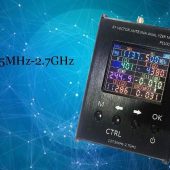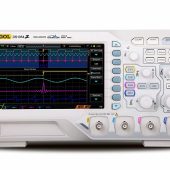A tachometer measures the speed of moving objects. You probably see a tachometer in action every day. The RPM gauge in vehicles is a tachometer. It measures engine speed.
Smaller handheld tachometers are great for DIYers, car mechanics, and industrial technicians.
A tachometer can easily measure the speed of rotating objects such as wheels, shafts, blades and so on. It can also be used to measure linear speed of something like a conveyor belt.
At home, you can use a tachometer to set the speed of your lawn mower, diagnose your car’s engine problems, or check whether your power tools are working at the right speed.
Analogue vs. Digital Tachometer
When we talk about a tachometer, we are referring to digital tachometers. There are analogue tachometers that show speed using a needle on a gauge (e.g. the one in many cars).
But analogue tachometers are less accurate compared to digital tachometers. Unlike digital tachometers, they also cannot store readings or calculate max, min, and average readings.
When shopping for a tachometer, get a digital one. It’s easy to use, it’s accurate, and you get a lot more functionality out of it.
Contact vs. Non-Contact Digital Tachometer
There are two types of digital tachometers: contact and non-contact.
Contact tachometers need to be in contact with the object whose speed you are measuring. It can be a small free spinning wheel or an adapter in which you insert the axle or shaft of a spinning object.
In many cases, however, you’ll find that using a contact tachometer is not possible or safe. For example, it can be dangerous to put your hand near fast spinning objects or the temperature of whatever you are measuring could be too high.
In such a situation, you need a non-contact digital tachometer.
A non-contact tachometer uses a laser to measure speed. It’ll usually come with reflective tape that you fix onto the spinning object. You can also use any white tape or draw a thick white line on the object.
As the laser shines onto the reflective part of the object, it is reflected back and the tachometer detects the reflected light.
How often light is reflected in a certain period (frequency), is used to calculate the speed of the object.
Some tachometers use the time between reflections, instead of frequency, to calculate speed. These are more accurate at measuring low speeds.
If you are wondering whether to get a contact or non-contact tachometer, we recommend getting both. You don’t need to buy two separate tachometers. You can easily find a 2-in-1 digital tachometer with a laser on one end and a contact adapter on the other.
How to Use a Contact Digital Tachometer
Before using a tachometer, make sure it has working batteries. Most new tachometers come with no batteries. If it has batteries, they are usually dead by the time you receive it.
You’ll need AA batteries or a 9V battery depending on the kind of tachometer you have. Check what the manual says.
Contact tachometers are pretty easy to use. The first step is to select the right head. Most contact tachometers come with several heads that you can swap between.
For measuring rotational speed, choose one of the smaller heads with a hole that you insert an axle or shaft into.
For linear speed, use the large head with a wheel. Depending on the tachometer you are using, you may also need to change the measurement units to metres or feet per minutes instead of RPM.
Measure speed, making sure to hold the tachometer in place until the reading stabilises.
The tachometer should have a button, usually the memory button, that displays the last speed measured. Some tachometers can also display the highest speed measured, lowest speed and average speed.
How to Use a Non-Contact Digital Tachometer
When measuring speed using the non-contact method, the most important thing is to make sure you have an adequately reflective section on the object you are measuring.
There needs to be good contrast between the main object and the reflective part. Otherwise, you’ll get erroneous readings.
If you are measuring a shiny object, you can use something like tape to darken it (wrap it around the wheel) and then use reflective tape to create a reflective section.
Press the laser button on the tachometer and make sure the light falls directly on the wheel. Hold the tachometer steady as the tachometer takes measurements.
Once the measurement stabilises, use the buttons on the tachometer to display the measured speed and other parameters such as min and max speed.
How to Improve the Accuracy of a Non-Contact Digital Tachometer
The accuracy of a non-contact digital tachometer depends a lot on how you use it.
You’ll probably notice that when you measure the same object several times, you may not get the same readings. That’s because of human error.
Here are a few tips to increase measuring accuracy when using a digital tachometer.
- Make the reflective portion wider. Reflective tape or a white line that’s too narrow could reduce accuracy.
- Hold the tachometer closer. The further you hold the tachometer from the object, the less accurate the measurement gets. Try to hold the tachometer at most 15cm from the object.
- If you are measuring a slow-rotating wheel, the standard frequency tachometer will be less precise. To improve accuracy, place reflective tape on two sections of the wheel, perhaps the 360-degree and 180-degree sections. This increases reflection frequency. But remember to divide the final reading by two to get the true RPM. You can also use three pieces of reflective tape then divide the final reading by three.
- Replace batteries as soon as the laser light begins to dim. A bright laser will measure speed more accurately.
If you need more help measuring speed with a digital tachometer, here’s a great video.
Do I Need to Calibrate my Digital Tachometer?
Typical consumer tachometers don’t need calibration. You can check to be sure it’s working properly by measuring the speed of a known object.
If you suspect a tachometer is showing inaccurate readings, it usually makes sense to buy a new one rather than bothering with calibration.
Advanced tachometers used in industrial and professional settings are calibrated regularly. But tachometer calibration requires skills and specialised equipment.
If you have a pricey tachometer you’d like to calibrate, the best choice is to send it to a lab that offers calibration services.


